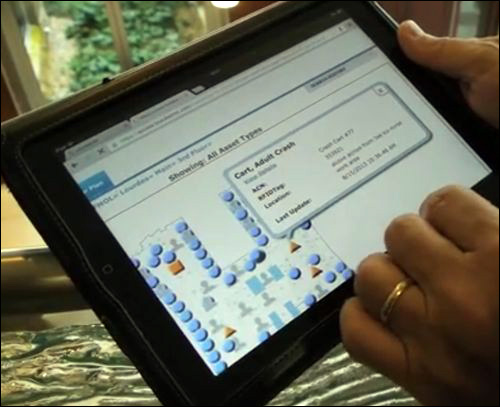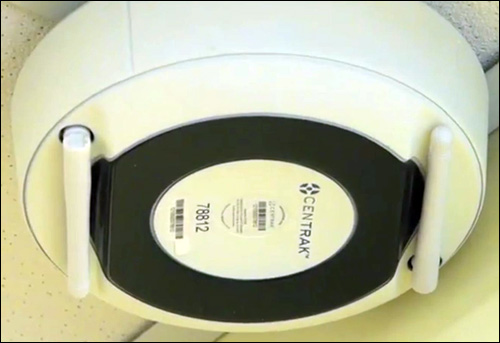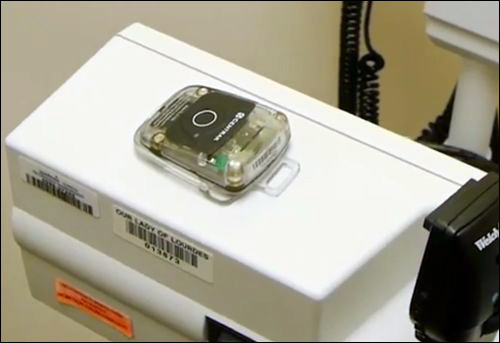Oct 22, 2013When it opened two years ago, the Our Lady of Lourdes Regional Medical Center, in Lafayette, La., had installed Skytron's Asset Manager real-time location system (RTLS) that provided it with insight into the movements and uses of its assets, while also improving staff performance. Earlier this year, the hospital, part of Louisiana-based Franciscan Missionaries of Our Lady Health System, expanded that deployment by adding RTLS staff badges. By tracking both employees and equipment, the facility reports that it has improved its ability to manage equipment, locate and contact staff members, and understand how and when it serves patients. The Our Lady Health System is now installing the RTLS solution within a new tower at the Our Lady of the Lake Regional Medical Center, in Baton Rouge, and plans to deploy the technology at a third hospital in the near future.
The data collected about tags and badges at all three hospitals will be managed on a centralized database. This, the organization explains, will allow it to better manage the locations of assets or personnel moving throughout each facility, as well as from one site to another.

Our Lady of Lourdes is a 420,000-square-foot hospital that houses 186 beds and employs 1,200 workers, including 400 physicians. The asset-management system enables the facility to easily conduct asset recalls, issue alerts in the event that items are discovered missing from a specific area, locate crash carts and other equipment, and know when assets on those carts are due to expire. In addition, the system can track staff responsiveness (by identifying employees' locations) and send messages to personnel via a bedside nurse-call system (by knowing in which room each worker is located).
The technology is designed to allow a hospital to document the length of time and frequency of visits that staff members spend with patients, says Bryant Broder, Skytron's senior product manager, and to identify new ways to make health care more efficient, based on data culled from the system.
CenTrak's Gen2IR emitters send infrared signals to CenTrak badges worn by the staff, as well as to CenTrak tags attached to specific assets—such as crash carts, wheelchairs and hospital beds—within range of a particular emitter. The tags and badges, in turn, transmit 900 MHz signals to RFID readers (which CenTrak refers to as wireless network devices) that forward that information to the Skytron Asset Manager software residing on the hospital's server.
Initially, the Skytron Asset Manager system installed by Our Lady of Lourdes employed tags and readers supplied by another RTLS vendor. While the hardware did identify assets and their locations, Broder says, the collected location data was not very specific; instead, each tag was located according to a particular zone. Last year, the hospital decided to expand the system to also include staff members, in order to locate and communicate with individuals throughout the facility, in addition to verifying where personnel were at any given time. If a patient complains that housekeeping has not visited his or her bed, for example, the software enables management to review read data collected from that location, verify or disprove that assertion, and then make any changes, if necessary, to staff training or scheduling.
If managers need to speak with a staff member, they can use the technology to determine his or her location so that they can contact that individual via the nurse-call system telephone at that location.
To accomplish all this, says Terry Broussard, Our Lady of Lourdes' VP of support services, room-level accuracy is vital. That is why Skytron replaced the RTLS hardware it previously installed with CenTrak's Clinical-Grade Visibility solution, which includes an IR emitter, also known as a monitor, mounted in each room.
Each asset tag was input into the system, and was linked in the software to a description and other details, such as a preventative-maintenance date. Staff badges were assigned to specific employees, each of whom is responsible for bringing his or her badge to work for every shift. Each worker's badge is attached to the access card that individual uses to enter secured areas of the hospital.
As a patient or asset moves around the facility, the CenTrak Clinical Grade Visibility solution transmits its ID number, along with the ID from the IR emitter within the vicinity, and the Asset Manager software displays that data for authorized users. Staff members must log onto the system by entering their user name and password, and are then granted access to predetermined amounts of information regarding the asset's location and status. The security requirements can be configured according to the hospital's needs, Broder says, ranging from requiring no sign-on or password to authorizing only specific authorized.
Employees can access the Skytron Asset Manager software to locate a particular item, determine its status and history, and learn when it may require servicing in the future. The software can also issue alerts to authorized users when an unexpected action takes place, such as a specific asset leaving through an unexpected doorway or at an unanticipated time, thus indicating a possible theft.
The hospital has set up PAR levels of some equipment in specific areas of the system. For example, if fewer than two wheelchairs are located in an area such as the ER lobby, an alert is sent to the appropriate personnel, indicating that they must locate and move a wheelchair to that area.
In the event of a recall, the technology provides data regarding a recalled item's location. Staff members simply input each recalled item into the system, and then view its location within the hospital. The Asset Manager software also provides a record of which rooms an asset has been in, which can then be matched with patient records to determine which patients may have received services with that device. If the recalled item is a pharmaceutical, the pharmacy would be able to sign into the software to ascertain a particular crash's cart location and the medication it contains.
If a large quality of assets are accumulating in the soiled room, for instance, the hospital's managers can receive a message alerting them to that situation.
In the future, Broussard says, he hopes to enable all personnel to use the technology for security purposes as well. For instance, if a worker was in danger from a patient, that employee could press a duress button on his or her badge, which would issue an emergency alert indicating the individual's location. That message could be received by management, or by other staff members on their pagers, such as security employees within the vicinity.
Tags have been attached to 1,274 assets to date, and badges are currently being worn by approximately 200 employees, including housekeepers, nutritional workers delivering meals, biomedical engineers and nurses.

According to Broussard, there have been some challenges to using the technology. For example, he says, although the system can identify the number of wheelchairs within a specific area, it cannot determine if those wheelchairs are in use. Eventually, he adds, he would like to expand the solution's use to include patient wristbands, so that the hospital could monitor patients as they move throughout the hospital.
Our Lady of Lourdes' RTLS installation has gone well, Broder says. "Everyone has been great to work with on this implementation, because they really get it," he states. "They realize they can save money."
According to Broussard, the system does, indeed, save the hospital money, by ensuring that equipment is not misplaced and then re-ordered unnecessarily. What's more, he notes, the technology helps to ensure that employees spend less time searching for missing items, and more time providing patient services.
"I think the technology has been a huge time-saver," Broussard says, "and it gives me the ability to make sound decisions about the reallocation of equipment."



